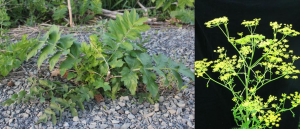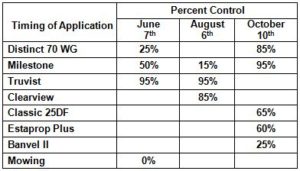Wild parsnip is a common weed in eastern Ontario, and is spreading in many other parts of the province. It is a biennial, or short-lived perennial (Figure 1). While wild parsnip does not have the notoriety of giant hogweed, its sap does contain some of the same chemicals (furanocoumarins). When these compounds come in contact with the skin, they cause severe burn-like rashes and/or blisters (Figure 2).


Description
Wild parsnip occurs mainly on roadsides, fencerows, pastures, and to a lesser extent, on the edges of cropped fields. Wild parsnip burns differ from rashes caused by poison ivy. The wild parsnip sap causes a skin reaction by destroying skin cell, whereas poison ivy causes an allergic skin reaction. More information on the biology of wild parsnip is available at: weedinfo.ca (http://bit.ly/KWmR6w).
Control
Wild parsnip can only be mechanically controlled by cutting the plant just below the soil surface. While mowing reduces seed production, it will not kill the plant or reduce the established wild parsnip population. Glyphosate is effective at controlling wild parsnip. However, glyphosate also destroys all the vegetation sprayed, which results in exposure of bare ground. This will usually lead to the establishment of new weeds, soil erosion and ditch bank destabilization.
OMAF and MRA field trials were conducted to evaluate the efficacy of a number of broadleaf weed herbicides, which would control wild parsnip without impacting grass vegetation in the lower canopy. Table 1 summarizes the percent visual control of wild parsnip obtained with different herbicides applied in June, August and October. Note that the efficacy of some products varied significantly based on the timing of application. Herbicides were not all evaluated at the 3 different times of application.

Truvist provided the most consistent control of wild parsnip at 95%. Truvist is currently going through the regulatory process and should be available for use in Ontario later this year. Of the herbicides currently available, Clearview provided the best control in these trials. For more information on products and product rates for the control of wild parsnip, refer to the ROADSIDES & NON-CROP AREAS section of OMAF Publication 75, Guide to Weed Control, available at: http://bit.ly/159Jnau.